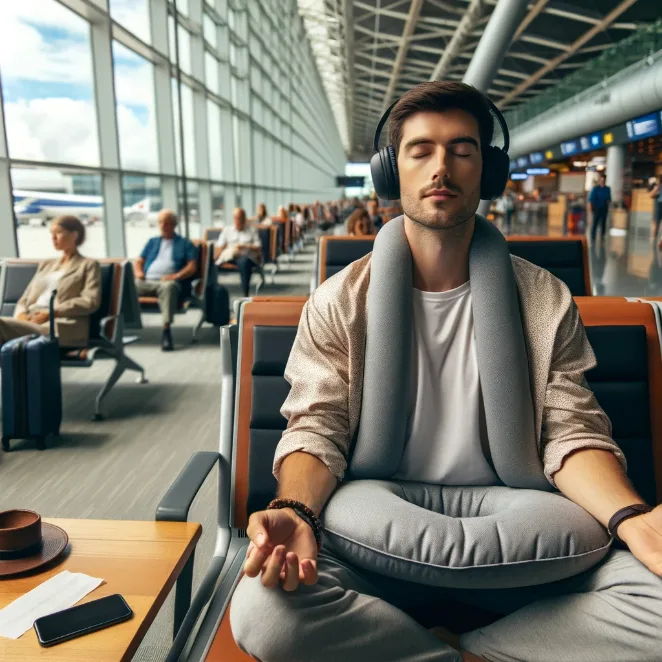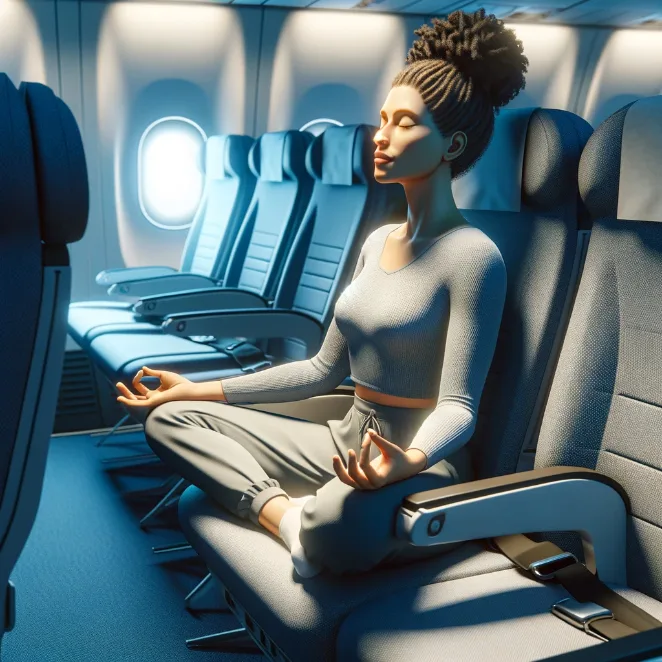
Serenity at 30,000 Feet: Meditation for Air Travel
Air travel, while an efficient means of transportation, often comes with its own set of stressors and anxieties. From the bustle of crowded airports to the confined spaces of airplanes, the journey can be taxing both physically and mentally. For frequent flyers and occasional travelers alike, finding a sense of calm amidst the chaos is crucial. This article explores the role of meditation in transforming air travel experiences, offering strategies to find peace and relaxation during flights. By integrating mindfulness and meditation techniques, travelers can turn their journey into an opportunity for relaxation and self-reflection.
article by Hina Kurosawa
Understanding Air Travel Anxiety
Air travel anxiety is a common experience, ranging from mild unease to severe phobias. "The act of flying, being in a crowded space, and the overall hustle of airports can trigger stress and anxiety," explains travel psychologist Dr. Sarah Williams. Factors like fear of heights, feeling of loss of control, or claustrophobia can intensify this anxiety. Even without specific fears, the disruption of routines, time zone changes, and long hours of sitting can lead to physical and mental discomfort. Recognizing these stress triggers is the first step in addressing them effectively. Meditation offers a powerful tool to not only alleviate these discomforts but also enhance the overall travel experience.

Meditation: A Path to Calm Skies
Meditation can be a traveler's ally, offering a way to maintain calm and balance. Simple mindfulness practices, like focused breathing or mindful observation, can be performed anywhere, even in a cramped airplane seat. "Taking a few minutes to meditate can significantly lower stress levels, helping travelers feel more relaxed and composed," Dr. Williams suggests. Meditation helps in shifting focus from external stressors to internal peace, creating a sense of control amidst the unpredictability of travel. It also aids in combating jet lag, as it can enhance the quality of rest and sleep. For anxious flyers, meditation provides a tool to manage fear, focusing the mind on the present rather than on worrisome thoughts about flying.
Practical Meditation Techniques for Travelers
Several practical meditation techniques can be particularly beneficial for air travelers. Deep breathing exercises, for instance, can be done discreetly and effectively, even in a crowded airplane. Guided meditations, available through various apps, offer an easy way to meditate, especially for beginners. Body scan techniques, where attention is focused sequentially on different parts of the body, can help in releasing physical tension. Visualization practices, imagining a peaceful place or situation, can also provide mental escape and relaxation. Even simple mindfulness practices, such as attentively observing one's surroundings, can serve as a form of meditation, turning the travel experience into a mindful journey.
Creating a Meditation-friendly Travel Environment
To facilitate meditation during air travel, a few preparatory steps can be helpful. Choosing comfortable clothing and bringing items like neck pillows or noise-canceling headphones can create a more conducive environment for relaxation. Informing travel companions about your intention to meditate can ensure uninterrupted time. Short, unobtrusive meditations are more practical during flights, considering the confined space and the presence of fellow passengers. Setting aside time for meditation during layovers or while waiting for boarding can also be beneficial. By planning ahead, travelers can seamlessly incorporate meditation into their journey, making their experience more peaceful and enjoyable.
Mindful Preparation: Setting the Stage for Relaxation
The foundation for a peaceful air travel experience often starts well before boarding the plane. Mindful preparation is key. This can involve packing well in advance to avoid last-minute stress, creating a relaxed travel itinerary, and even engaging in meditation sessions days before the journey. "Preparing your mind for travel is as important as packing your bags," says mindfulness coach Elaine Foster. She recommends starting a meditation routine a few days before departure to help the mind get accustomed to the practice. This preparatory stage not only reduces pre-travel anxiety but also sets a calm and mindful tone for the entire journey, making the transition into travel more seamless and less jarring.

The Role of Digital Tools in Travel Meditation
In today's digital age, various tools and apps can significantly enhance the meditation experience for travelers. Many apps offer guided meditations specifically designed for travel-related stress and anxiety. These digital guides can be particularly helpful for beginners or those finding it challenging to focus amid the distractions of travel. "Using a meditation app during a flight has helped me manage my fear of flying," shares frequent flyer Julia Hernandez. In addition to guided sessions, these apps often include features like calming music or nature sounds, which can be beneficial in creating a tranquil environment, even in a busy airport or a cramped airplane. By leveraging these digital resources, travelers can access the benefits of meditation anytime and anywhere, adding an extra layer of tranquility to their journeys.
Integrating meditation into air travel can transform an often stressful experience into a more serene and enjoyable journey. By practicing mindfulness and relaxation techniques, travelers can navigate the challenges of flying with greater ease and composure. Meditation not only alleviates travel-related stress but also enhances the overall well-being of travelers. As meditation becomes a regular travel companion, the skies become not just a pathway to a destination but a space for personal tranquility and rejuvenation.
Published: 11/23/2023
Modified: 11/23/2023
More predictions
Come back here soon to learn more about yourself and your future


Subconscious Journeys: Meditation and Hypnosis
The exploration of the human mind has long been a subject of fascination, with meditation and hypnosis standing as two powerful methods for delving into the subconscious. While both practices differ in approach and execution, they share a common goal: to traverse the deeper realms of the mind and unlock its potential. This article examines the intersection of meditation and hypnosis, highlighting their unique methodologies, benefits, and how they complement each other in the journey towards self-discovery and personal growth. By understanding these practices, one can gain a deeper insight into the workings of the subconscious mind and harness its power for positive change.


The Physiology of Meditation: What Happens Inside
Meditation, a practice that transcends cultures and centuries, offers more than just mental tranquility. Beyond its serene exterior lies a complex interplay of physiological processes that significantly impact the human body. As science delves deeper into these processes, the profound physical effects of meditation become increasingly evident, enhancing our understanding of this ancient practice. This article explores the intricate physiological changes that occur during meditation and their overarching impact on health and well-being.


The Verdict On Meditation Retreats
In the bustling heart of New York City, amidst the symphony of honking taxis and chattering crowds, Julia often found herself yearning for a moment of silence. Life, with its endless demands, had left her drained. The idea of a meditation retreat, a sanctuary away from the chaos, had been lingering in her mind. But the looming question remained: are meditation retreats truly worth it?